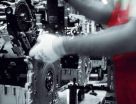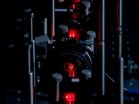(Press-News.org) This release is available in German.
Valves, nozzles, pistons, spark plugs and camshafts – the heart of each car is its engine. It is a complex structure with many levels and individual parts and must therefore be assembled in a correspondingly precise way. Parts that are slightly damaged, malformed or assembled the wrong way can cause engine damage. The results would be an angry customer and damage to the reputation of the car manufacturer.
While assembly is mostly automated for the construction of the body, the engine is still assembled by hand over long stretches. The current methods for automating engine assembly have proven either useless or too expensive. The work of the project group "Resource-efficient mechatronic processing machines" of the Fraunhofer Institute for Machine Tools and Forming Technology IWU under the management of Prof. Dr.-Ing. Gunther Reinhart shows greater promise. In cooperation with the car manufacturer Audi, the engineers initiated the project: "Forward-looking methods and processes for precision assembly and process monitoring for novel combustion engines." The objective is clearly defined: the quality of the engine assembly is to be optimized continuously, therefore increasing customer satisfaction further. The use of the latest technologies in the areas of robotics and sensor technology is intended to help eliminate uncertainties during engine assembly. "Monitoring the process throughout is not possible, since the engine continues to be assembled mostly manually. And engines are becoming more complex all the time. This can cause increased levels of rework," says graduated engineer Christoph Sieben from the IWU. The automated assembly technology of the IWU scientists would identify the defect early, during engine assembly, and forward the corresponding information or, for certain assembly processes, would not permit the defect to occur in the first place.
The researchers first catalogued the status quo, evaluating current data on documented, assembly-related engine problems for in-line and V-type engines over the past five years. The focus of the analysis was on the parts used and on the processes involved. "We generalized the engine assembly sequence and broke it down into eight blocks. The individual assembly functions are also recorded in a standardized way," declares Christoph Sieben. This makes it possible to assign errors during assembly to uniformly defined assembly sequences and assembly functions. As a result of this generalization of engine assembly, the analysis can be utilized for all kinds of engines. "We now know which assembly sequences require action," says Christoph Sieben. The project group wants to develop new automation solutions next. The core piece of the test facility is a new type of lightweight robot: it weighs only 16 kilograms but can lift up to seven kilograms. What is so special about the "KUKA robot"? It is very sensitive and flexible, unlike other traditional robots that can perform tasks only within certain parameters. The researchers are now looking for new ways to combine innovative sensor technology and robots. "For example, we are pondering how a transfer from medical sensor technology to industrial processing could be effected," elaborates Christoph Sieben.
A high-performance control technology can be developed by integrating sensor systems of many variations: ideally, the robot will not only detect the problem, it will also solve it. Camera systems that record the directional orientation of a part are a current example. If it does not correspond to the standard, the robot can decide whether the part will be used or if it has to be replaced. Christoph Sieben explains: "The process monitoring system that is to be developed further on this basis has the ability to automatically deduce the inspection criteria and the required tolerances during the entire assembly process and then to react." The project will end in 2014. The plan is that the prototype will then be ready for series production.
INFORMATION:
Precise assembly of engines
2011-06-25
ELSE PRESS RELEASES FROM THIS DATE:
New Jersey Institute for Continuing Legal Education; The Changing Culture of ADR: From the Court House and Beyond
2011-06-25
The 14th annual conference is the premier, daylong, and statewide conference for Alternative Dispute Resolution professionals: negotiators, mediators, arbitrators and neutral experts, with special presentations and interactive workshops on today's cutting-edge ADR issues.
It is a "must attend" event for all attorneys, arbitrators, mediators and other professionals who want to enhance their conflict management techniques.
The Conference Sessions are taught by highly authoritative national and state experts, providing proven practice tips, CLE credits, and ...
Crafting a Parenting Plan for Unwed Parents
2011-06-25
Making arrangements for child custody and visitation can be difficult in the best of situations, but even more so if the parents are unmarried. Unwed parents have to work even harder to ensure that the best interests of their children are protected when making decisions about child custody and parenting time (perhaps better known as "visitation"). Since roughly 40 percent of children are now born out of wedlock, issues surrounding parenting plans for the children of unmarried parents are more important than ever.
While it is always advisable to craft a comprehensive ...
Optical circuit enables new approach to quantum technologies
2011-06-25
Professor Jeremy O'Brien, Director of the University of Bristol's Centre for Quantum Photonics, and his Japanese colleagues have demonstrated a quantum logic gate acting on four particles of light – photons. The researchers believe their device could provide important routes to new quantum technologies, including secure communication, precision measurement, and ultimately a quantum computer—a powerful type of computer that uses quantum bits (qubits) rather than the conventional bits used in today's computers.
Unlike conventional bits or transistors, which can be in one ...
Mantis shrimp eye could improve high-definition CDs, DVDs
2011-06-25
The eye of the peacock mantis shrimp has led an international team of researchers to develop a two-part waveplate that could improve CD, DVD, blu-ray and holographic technology, creating even higher definition and larger storage density.
Peacock mantis shrimp are one of only a few animal species that can see circularly polarized light -- like the light used to create 3-D movies. Some researchers believe the mantis shrimp's eyes are better over the entire visual spectrum than any man-made waveplates.
A waveplate is a transparent slab that can alter the polarization of ...
When It Comes to Teen Driving, Attitude Beats Age
2011-06-25
According to Maryland driving instructor Charlie Hook (who has been teaching people how to drive for more than 40 years), teen drivers can be "just as good" as drivers with years of experience, as Vanessa Junkin of the Carroll County Times reports.
But, Hook also said, "The attitude's more important than anything," weighting attitude as a heavier factor than age when it comes to good driving.
And when you think of attitude, you think of your orientation to responsible driving. A teen driver with the right attitude will avoid drinking and driving, ...
Astronomers reach for the stars to discover new cancer therapy
2011-06-25
COLUMBUS, Ohio – Astronomers' research on celestial bodies may have an impact on the human body.
Ohio State University astronomers are working with medical physicists and radiation oncologists to develop a potential new radiation treatment – one that is intended to be tougher on tumors, but gentler on healthy tissue.
In studying how chemical elements emit and absorb radiation inside stars and around black holes, the astronomers discovered that heavy metals such as iron emit low-energy electrons when exposed to X-rays at specific energies.
Their discovery raises the ...
'Quantum magic' without any 'spooky action at a distance'
2011-06-25
This release is available in German.
The quantum mechanical entanglement is at the heart of the famous quantum teleportation experiment and was referred to by Albert Einstein as "spooky action at a distance". A team of researchers led by Anton Zeilinger at the University of Vienna and the Institute for Quantum Optics and Quantum Information of the Austrian Academy of Sciences used a system which does not allow for entanglement, and still found results which cannot be interpreted classically. Their findings were published in the latest issue of the renowned scientific ...
Keeping Your Head Above Water in an Illinois Foreclosure
2011-06-25
In September and October 2010, several major mortgage lenders confessed that many of their employees had been signing and notarizing home foreclosure documents (affidavits) without reviewing their content. Lenders including GMAC/Ally, Bank of America and JP Morgan Chase all revealed they had filed thousands of documents without verifying the underlying mortgage information.
As these documents were used in court proceedings, the inaccuracies often resulted in unintended and unfortunate outcomes for people trying to salvage what they could after a foreclosure. The revelation ...
Young people with type 1 diabetes at risk for heart disease
2011-06-25
AURORA, Colo. (June 25, 2011) New research shows that adolescents and young adults with type 1 (juvenile) diabetes have thicker and stiffer carotid arteries, also known as atherosclerosis, a risk factor for heart attack and stroke in adults. This research is believed to be the first to examine whether type 1 diabetes has a measurable effect on carotid arteries in this age group.
The research is part of The SEARCH CVD Study, a collaborative effort between investigators at the Colorado School of Public Health and the Cincinnati Children's Hospital Medical Center. Dana ...
Drug shows improved kidney function for type 2 diabetics, UT Southwestern researchers report
2011-06-25
DALLAS – June 24, 2011 – A new anti-inflammatory drug used by patients with type 2 diabetes improved their kidney function during a year-long study involving researchers from UT Southwestern Medical Center.
The study findings, reported in today's New England Journal of Medicine, mark the first time a drug therapy has led to improved kidney function for patients with type 2 diabetes and chronic kidney disease. Previous studies have identified drugs that slowed the deterioration of kidney function, said Dr. Robert Toto, director of the Houston J. and Florence A. Doswell ...


